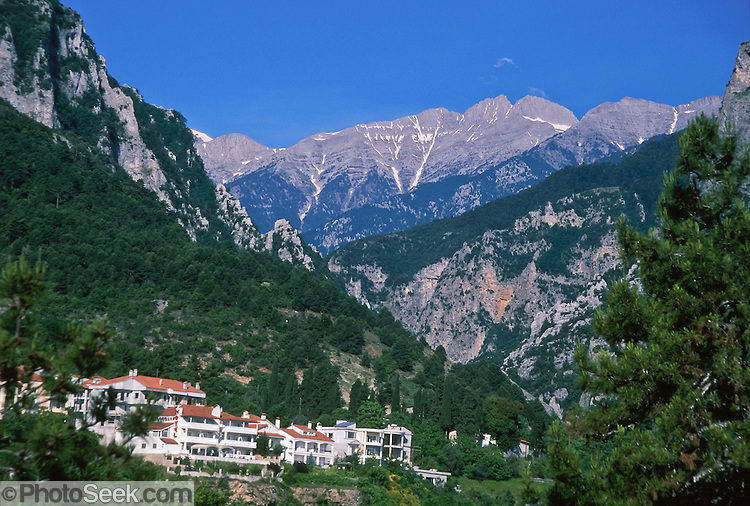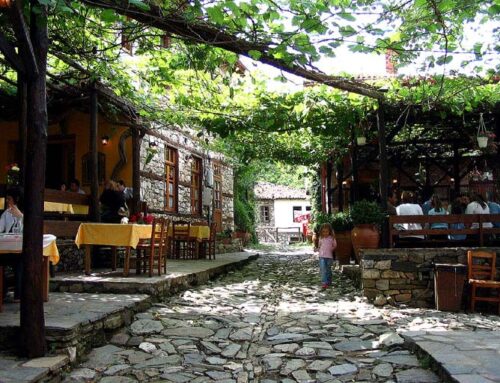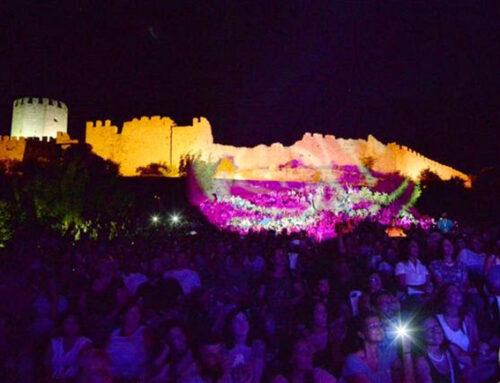Project Description
Mount Olympus is the highest mountain inGreece and the second highest mountain in the Balkans. It is located in the Olympus Range on the border between Thessaly and Macedonia, between the regional units of Pieria and Larissa, about 80 km (50 mi) southwest from Thessaloniki. Mount Olympus has 52 peaks, deep gorges, and exceptional biodiversity. The highest peak Mytikas, meaning “nose”, rises to 2,919 metres (9,570 ft). It is one of the highest peaks in Europe in terms of topographic prominence.
Olympus was notable in Greek Mythology as the home of the Twelve Olympians, on the Mytikas peak. Mount Olympus is also noted for its very rich flora with several species. It has been the first National Park of Greece, since 1938, and a World’s Biosphere Reserve.
Every year thousands of people visit Olympus to admire its nature, to tour its slopes, and reach its peaks. Organized mountain refuges and various mountaineering and climbing routes are available to visitors, who want to explore its nature. The usual starting point for it is the town of Litochoro, on the eastern foothills of the mountain, 100 km from Thessaloniki, where, in the beginning of every summer, the Mountain Olympus Marathon terminates.
Mythology
In Greek mythology Olympus was the home of the Twelve Olympian gods of the ancient Greek world. In myth, Olympus formed after the gods defeated the Titans in the Titan War, and soon the place was inhabited by the gods. It is the setting of many Greek mythical stories. The Twelve Olympian gods lived in the gorges, where there were also their palaces. Pantheon (today Mytikas) was their meeting place and theater of their stormy discussions. The Throne of Zeus (today Stefani) hosted solely him, the leader of the gods. From there he unleashed his thunderbolts, expressing his godly wrath. The Twelve Olympians included also Hera, Hestia, Demeter, Poseidon, Athena, Apollo, Artemis, Hermes, Aphrodite, Ares and Hephaestus. Ιn Iliad Olympus is referred as great, long, brilliant and full of trees.
In Pieria, on Olympus’ northern foot, the mythological tradition had placed the nine Muses, patrons of the Fine Arts, daughters of Zeus and the Titanide Mnemosyne : Calliope (Epic Poetry), Clio(History), Erato (Love Poetry), Euterpe (Music), Melpomene, (Tragedy), Polyhymnia (Hymns), Terpsichore (Dance), Thalia (Comedy) and Urania (Astronomy).
Climate
Generally speaking Olympus’ climate can be described as one of mediterranean type with continental influence. Its local variations is the result of the impact of the sea and the rugged relief of the region.
In the lower locations (Litochoro and the foothills) the climate is typically mediterranean, i.e. hot and dry in the summer, while humid and cold in the winter. Higher it is more humid and severe, with more intense phenomena ; in these locations it often snows all over the winter, while raining and snowing is not unusual, even in the summer. The temperature varies in the winter from -10 °C to 10 °C and in the summer from 0 °C to 20 °C, while winds are an almost everyday occurrence. Generally the temperature falls 1 °C per 200 m of altitude. As the altitude rises, the phenomena are more intense and the variations of temperature and humidity are often sudden. The coastal northeast slopes of Olympus receive more rain than the continental northwest, so, as a result, there is a clear difference in vegetation. being more abundant in the first of them. Hottest month is August, while coldest is February.
The mountain’s highest zone, over 2,000 metres, is snowcapped for about nine months (September to May). In some places the winds gather snow, 8–10 metres thick, (‘anemosouria’ in Greek), while in some deep ravines the snow is maintained all over the year (everlasting snow). For this Olympus’ alpine region, recordings have been made in the 1960s in the highest-altitude weather station in Greece, that was established on the summit of Aghios Antonios (2,815 m), providing a number of interesting data for the mountain’s climate. Τhe average temperature is -5 °C in winter and 10 °C in summer. The average annual precipitation heights vary from 149 cm at Prionia (1,100 m) to 170 cm at Aghios Antonios, about half of them rainfall and hailstorms in summer and the rest snowfall in winter. The weather may change several times in the same day.
In summer rainfalls are frequent, commonly as evening thunderstorms, many times accompanied by hail and strong winds. However water springs over 2,000 metres are scarce and visitors should ensure that they have always water and of course the necessary clothing for any weather conditions.
Hiking Trails
Popular among visitors and hikers, are the many trails and paths of Mount Olympus. Most important of them is E4 European long distance path, that runs west of Litochoro towards the peaks, through Enipeas’ gorge. There is also the National path O2, that connects the peaks southward to Pelion.
In many places there are sitting areas near springs and fountains for visitors. The Forest Service has placed in several locations information signs with a map of the National Park and useful guidelines. Visitors who have time enough can climb to the peak by the second path and then descend by the first, night stopping in one of the refuges.
Mountaineering Paths
Olympus’ mountaineering paths start from Litochoro, Dion and Petra. Summer climbs usually start by early June and end in late September. During this season the refuges below the peaks are open and the weather enables a climb without snow equipment and mountaineering experience that winter requires. The climb to the highest peaks in winter can be done only by experienced mountaineers, for which there are also challenging climbing paths on steep slopes. Beginners visitors should be limited to the summer months, when refuges operate normally.
Two popular trails for exploring Olympus start from Litochoro and reach to the peaks of the mountain. The first one follows Enipeas’ gorge and begins with a five-hour hike to ΄΄Prionia΄΄ (elevation 1,100 m), where in the past operated a sawmill (Prionia means saws in Greek). This is also accessible by car via an 18 km route. From Prionia, following the European Path E4, the climber, it is about a two and a half hour hike to the well known refuge, ΄΄Spilios Agapitos΄΄ (2,100 m). From the refuge to Olympus’ peaks is another two and a half hours.
At the 10th km of the road from Litochoro to Prionia, at the site ΄΄Stavros΄΄, there is the refuge ΄΄Dim. Bountolas΄΄ (944 m), that, after the construction of the road, operates primarily as cafe-restaurant. Along the road there are parking places, where one can stop and enjoy the scenery. Four km before the end of the road at Prionia, in the site ΄΄Gortsia΄΄, where there is a car park, starts a second, alternative, path, that leads to Olympus’ peaks. From this point, after about five hours of hiking, passing consecutively the sites Barba, Petrostrouga, Skourta and Lemo, the climber arrives to Muses’ Plateau (2,600 m), where he can rest in two refuges, ΄΄Giosos Apostolidis΄΄ and ΄΄Christos Kakalos΄΄. From here the path to the mountain’s peak is relatively easy and one can reach in about an hour.







